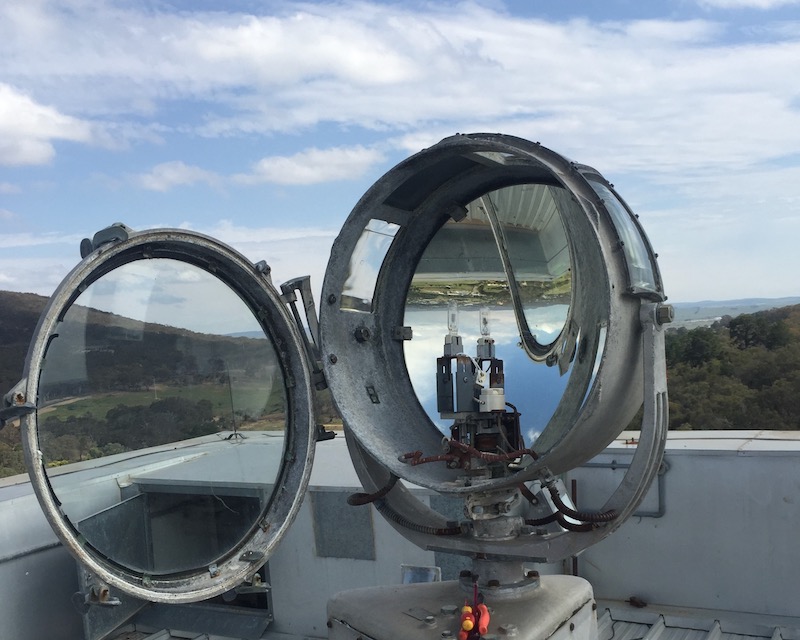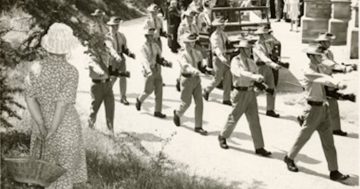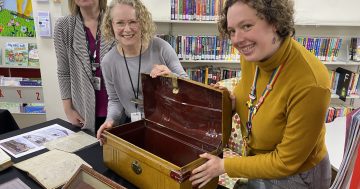
The Rocky Hill War Memorial searchlight was installed in Goulburn in 1936 and is now showing its age. Photo: Stephen Yeadon.
Time is catching up with the Rocky Hill War Memorial’s searchlight in Goulburn.
As it continues to show its age, a handful of skilled people are nursing the infrastructure along and searching the world for a suitable replacement – a difficult task given land-based searchlights have long been retired.
Installed in 1936 with a powerful radius of 129km to guide night-flying planes from Goulburn airport, the searchlight became redundant in 1953 when technology took over directing flights. The light was switched back on in 1955 and has been regarded with deep affection within the city situated 100 metres below the tower’s famous beacon ever since.
Electrician Stephen Yeadon, his nephew, Jack, and electrical fitter mechanic, John Griffin, continue generations of care to keep the old searchlight turning atop the 20-metre high memorial. Every decade or so, Stephen climbs the staircases inside the memorial, gets onto the roof and marvels at the 360-degree panorama.
In 1950, the view was described as looking over a million acres of the mountains and plains of the tablelands.
When the revolving light’s small, purpose-built engine’s copper wiring burnt out, Stephen took it to Lee & Thomas Auto Electrical where John Griffin replaced and rewound the wiring and fixed other issues. He is the only person in town who can do the specialist work, which his father, Patrick, did before him.
Replacing equipment on the tower roof requires two people. Stephen was helped by Jack to re-wire all the rusting wire, replacing the lamp housing and installing the rewound motor and lamp holders that he sourced from Italy.
Manufactured by Australian General Electric when the large, 3000-candle-power light triple reflected to throw a one-million-candle power light, the lamp was the first of its kind installed in Australia. Its original lens was replaced about 10 years ago, the glass cover custom-made for the job, according to Stephen.
For anyone born in Goulburn, the searchlight and tower are an inheritance much like Mother Nature’s natural beauty, ever changing yet as consistent and peaceful as dawn. When the powerful light softens the tips of storm clouds or turns shafts of rain showers into silver streaks around the stone tower, Goulburnians feel blessed.

Rocky Hill War Memorial in Goulburn at night. Photo: James Groves.
The Commonwealth Department of Aviation enlisted engineers to build the beacon and have it complete six revolutions a minute. The council maintained it as part of the Rocky Hill War Memorial and Museum caretaker’s duties.
The government paid Eric Keith two pounds a month to maintain the beacon. The 14 March, 1950, Goulburn Evening Post described Eric as the gentle-voiced guardian of the memorial. He ran a small school tuck shop before his caretaker’s role. A German shell embedded 40 lumps of shrapnel in his back during World War I, which later lead to an ultimatum from his doctor: leave his shop or die within six months.
During the next 14 years, he worked at the memorial.
“He depends on the sixpences of tourists for his livelihood, on those and the small tea rooms run by himself and his wife in the council cottage on Rocky Hill,” the newspaper reported. Eric memorised all the facts and figures connected with the memorial, reeling them off thousands of times a year for tourists.
In 1955, Goulburn Chamber of Commerce noted that, after a period of the light being turned off, it was switched on during Lilac Time festivities. “My chamber feels that this light is part of the City of Goulburn, and as I understand it, the annual cost is approximately 80 pounds. It is suggested perhaps the council and the Southern Tablelands Country Council would bear half of this cost,” the chamber’s secretary wrote.
The council bought the beacon, continued maintaining it and has recognised its significance with an illustrated light beam forming part of the Goulburn Mulwaree Council logo.
Since restoration work in the 1990s, council has tried to find a replacement beacon for the well-worn device. The Australian Government could not help.
Council’s museums coordinator Kerry Ross, as gentle-voiced and passionate as her predecessors, says last year the council bought the remaining 16 lamp bulbs in Australia.
Kerry says when the beacon was not working, Goulburnians would ring council and the local RSL, and enquire on social media pages, asking when it would be up and running again.
“This is a reminder the beacon is a much-loved part of the memorial site and has a significant presence in the local community,” she says.
Original Article published by John Thistleton on The RiotACT.











